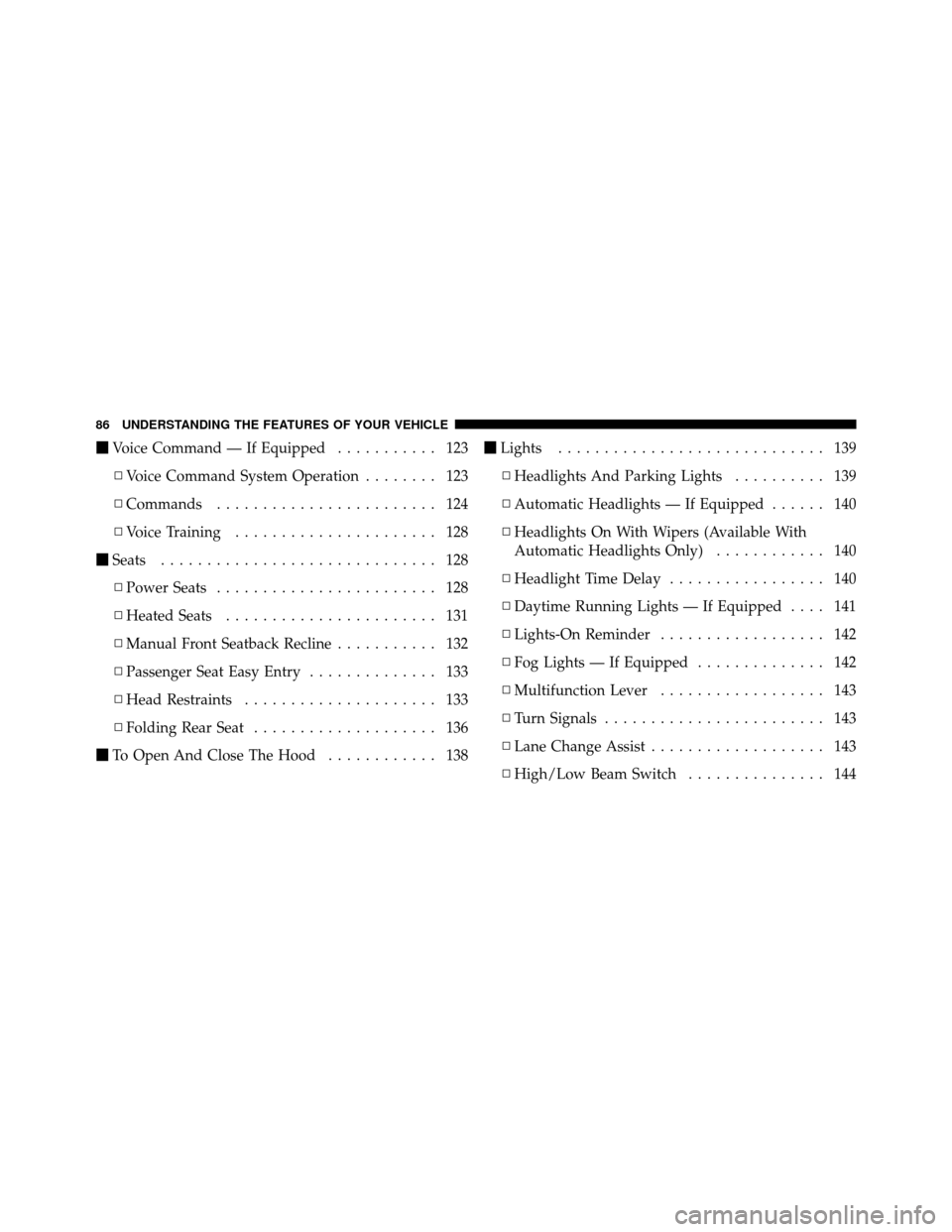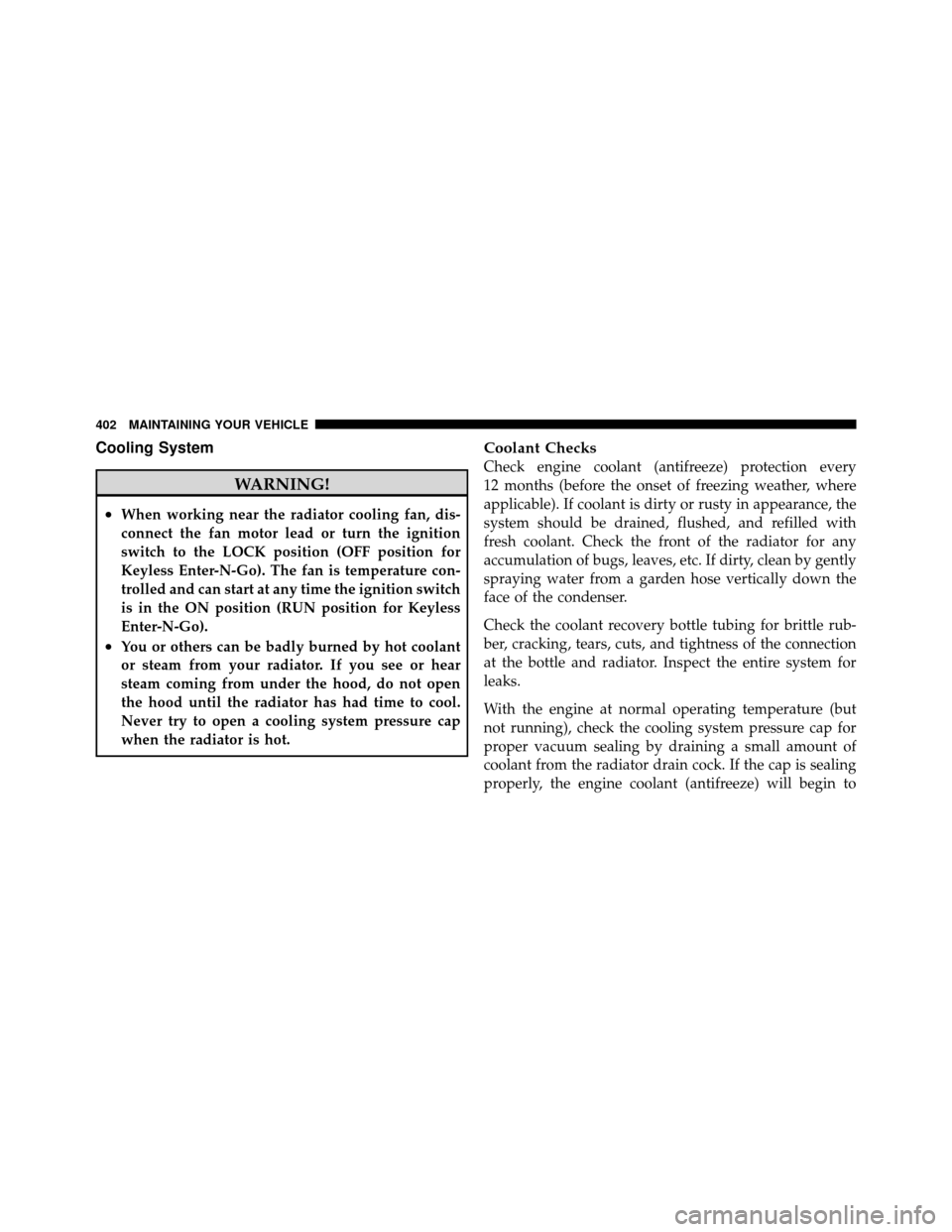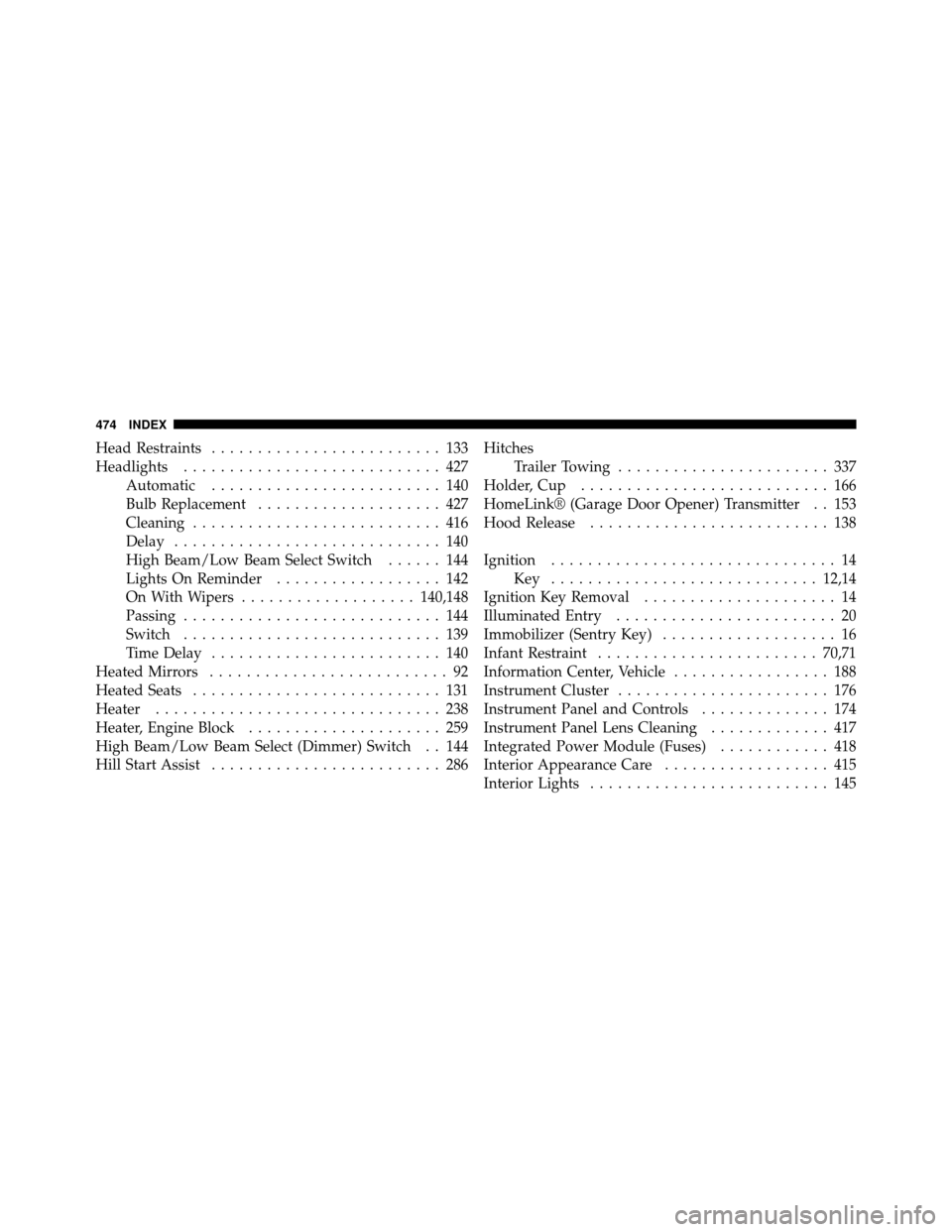Page 32 of 490
Cancel Remote Start
Remote Starting will also cancel if any of the following
occur:
•The engine stalls or engine speed exceeds 2500 rpm
•Any engine warning lights come on
•Fuel lamp turns on
•The hood is opened
•The hazard switch is pressed
•The shift lever is moved out of PARK
DOOR LOCKS
Manual Door Locks
To lock each door, push the door lock knob on each door
trim panel downward. To unlock each door, pull the door
lock knob on each door trim panel upward.If the door lock knob is down when you shut the door,
the door will lock. Therefore, make sure the Key Fob is
not inside the vehicle before closing the door.
Door Lock Knob
30 THINGS TO KNOW BEFORE STARTING YOUR VEHICLE
Page 88 of 490

�Voice Command — If Equipped ........... 123
▫ Voice Command System Operation ........ 123
▫ Commands ........................ 124
▫ Voice Training ...................... 128
� Seats .............................. 128
▫ Power Seats ........................ 128
▫ Heated Seats ....................... 131
▫ Manual Front Seatback Recline ........... 132
▫ Passenger Seat Easy Entry .............. 133
▫ Head Restraints ..................... 133
▫ Folding Rear Seat .................... 136
� To Open And Close The Hood ............ 138�
Lights ............................. 139
▫ Headlights And Parking Lights .......... 139
▫ Automatic Headlights — If Equipped ...... 140
▫ Headlights On With Wipers (Available With
Automatic Headlights Only) ............ 140
▫ Headlight Time Delay ................. 140
▫ Daytime Running Lights — If Equipped .... 141
▫ Lights-On Reminder .................. 142
▫ Fog Lights — If Equipped .............. 142
▫ Multifunction Lever .................. 143
▫ Turn Signals ........................ 143
▫ Lane Change Assist ................... 143
▫ High/Low Beam Switch ............... 144
86 UNDERSTANDING THE FEATURES OF YOUR VEHICLE
Page 140 of 490
TO OPEN AND CLOSE THE HOOD
Two latches must be released to open the hood.
1. Pull the hood release lever located under the left side
of the instrument panel.2. Move to the outside of the vehicle and push the safety
catch to the left. The safety catch is located under the
center front edge of the hood.
Hood Release Lever
Hood Safety Catch
138 UNDERSTANDING THE FEATURES OF YOUR VEHICLE
Page 141 of 490
CAUTION!
To prevent possible damage, do not slam the hood to
close it. Lower the hood until it is open approxi-
mately 6 in (15 cm), and then drop it. This should
secure both latches. Never drive your vehicle unless
the hood is fully closed, with both latches engaged.
WARNING!
Be sure the hood is fully latched before driving your
vehicle. If the hood is not fully latched, it could open
when the vehicle is in motion and block your vision.
Failure to follow this warning could result in serious
injury or death.
LIGHTS
Headlights And Parking Lights
The headlight switch is located on the left side of the
instrument panel. This switch controls the operation of the
headlights, parking lights, instrument panel lights, instru-
ment panel light dimming, interior lights and fog lights.
Headlight Switch
3
UNDERSTANDING THE FEATURES OF YOUR VEHICLE 139
Page 352 of 490

•You can also turn the temperature control to maximum
heat, the mode control to floor and the blower control
to high. This allows the heater core to act as a
supplement to the radiator and aids in removing heat
from the engine cooling system.
CAUTION!
Driving with a hot cooling system could damage
your vehicle. If the temperature gauge reads 240°F
(116 °C) or greater pull over and stop the vehicle. Idle
the vehicle with the air conditioner turned off until
the pointer drops back into the normal range 200–
230°F (93–110°C). If the pointer remains at 240°F
(116°C) or greater and you hear a chime, turn the
engine off immediately and call for service.
WARNING!
You or others can be badly burned by hot engine
coolant (antifreeze) or steam from your radiator. If
you see or hear steam coming from under the hood,
do not open the hood until the radiator has had time
to cool. Never try to open a cooling system pressure
cap when the radiator or coolant bottle is hot.
TIREFIT KIT — IF EQUIPPED
Small punctures up to1�4in (6 mm) in the tire tread can be
sealed with TIREFIT. Foreign objects (e.g., screws or
nails) should not be removed from the tire. TIREFIT can
be used in outside temperatures down to approximately
-4°F (-20°C).
This kit will provide a temporary tire seal, allowing you
to drive your vehicle up to 100 miles (160 km) with a
maximum speed of 55 mph (88 km/h).
350 WHAT TO DO IN EMERGENCIES
Page 374 of 490

WARNING!
•Take care to avoid the radiator cooling fan when-
ever the hood is raised. It can start anytime the
ignition switch is on. You can be injured by
moving fan blades.
•Remove any metal jewelry such as watch bands or
bracelets that might make an inadvertent electrical
contact. You could be seriously injured.
•Batteries contain sulfuric acid that can burn your
skin or eyes and generate hydrogen gas which is
flammable and explosive. Keep open flames or
sparks away from the battery.
1. Set the parking brake, shift the automatic transmission
into PARK and turn the ignition to LOCK.
2. Turn off the heater, radio, and all unnecessary electri-
cal accessories. 3. If using another vehicle to jump-start the battery, park
the vehicle within the jumper cables reach, set the
parking brake and make sure the ignition is OFF.
WARNING!
Do not allow vehicles to touch each other as this
could establish a ground connection and personal
injury could result.
Jump-Starting Procedure
WARNING!
Failure to follow this procedure could result in per-
sonal injury or property damage due to battery ex-
plosion.
372 WHAT TO DO IN EMERGENCIES
Page 404 of 490

Cooling System
WARNING!
•When working near the radiator cooling fan, dis-
connect the fan motor lead or turn the ignition
switch to the LOCK position (OFF position for
Keyless Enter-N-Go). The fan is temperature con-
trolled and can start at any time the ignition switch
is in the ON position (RUN position for Keyless
Enter-N-Go).
•You or others can be badly burned by hot coolant
or steam from your radiator. If you see or hear
steam coming from under the hood, do not open
the hood until the radiator has had time to cool.
Never try to open a cooling system pressure cap
when the radiator is hot.
Coolant Checks
Check engine coolant (antifreeze) protection every
12 months (before the onset of freezing weather, where
applicable). If coolant is dirty or rusty in appearance, the
system should be drained, flushed, and refilled with
fresh coolant. Check the front of the radiator for any
accumulation of bugs, leaves, etc. If dirty, clean by gently
spraying water from a garden hose vertically down the
face of the condenser.
Check the coolant recovery bottle tubing for brittle rub-
ber, cracking, tears, cuts, and tightness of the connection
at the bottle and radiator. Inspect the entire system for
leaks.
With the engine at normal operating temperature (but
not running), check the cooling system pressure cap for
proper vacuum sealing by draining a small amount of
coolant from the radiator drain cock. If the cap is sealing
properly, the engine coolant (antifreeze) will begin to
402 MAINTAINING YOUR VEHICLE
Page 476 of 490

Head Restraints......................... 133
Headlights ............................ 427
Automatic ......................... 140
Bulb Replacement .................... 427
Cleaning ........................... 416
Delay ............................. 140
High Beam/Low Beam Select Switch ...... 144
Lights On Reminder .................. 142
On With Wipers ................... 140,148
Passing ............................ 144
Switch ............................ 139
Time Delay ......................... 140
Heated Mirrors .......................... 92
Heated Seats ........................... 131
Heater ............................... 238
Heater, Engine Block ..................... 259
High Beam/Low Beam Select (Dimmer) Switch . . 144
Hill Start Assist ......................... 286 Hitches
Trailer Towing ....................... 337
Holder, Cup ........................... 166
HomeLink® (Garage Door Opener) Transmitter . . 153
Hood Release .......................... 138
Ignition ............................... 14
Key ............................. 12,14
Ignition Key Removal ..................... 14
Illuminated Entry ........................ 20
Immobilizer (Sentry Key) ................... 16
Infant Restraint ........................ 70,71
Information Center, Vehicle ................. 188
Instrument Cluster ....................... 176
Instrument Panel and Controls .............. 174
Instrument Panel Lens Cleaning ............. 417
Integrated Power Module (Fuses) ............ 418
Interior Appearance Care .................. 415
Interior Lights .......................... 145
474 INDEX